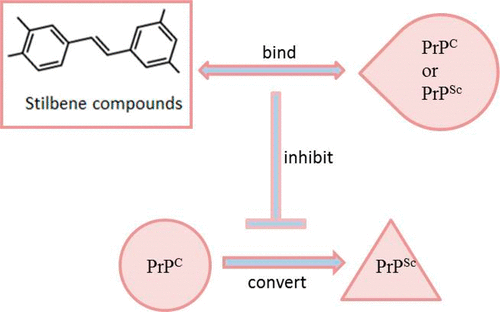当前位置:
X-MOL 学术
›
ACS Chem. Neurosci.
›
论文详情
Our official English website, www.x-mol.net, welcomes your
feedback! (Note: you will need to create a separate account there.)
Stilbene Compounds Inhibit the Replications of Various Strains of Prions in the Levels of Cell Culture, PMCA, and RT-QuIC Possibly via Molecular Binding.
ACS Chemical Neuroscience ( IF 4.1 ) Pub Date : 2020-06-08 , DOI: 10.1021/acschemneuro.0c00218 Dong-Hua Zhou 1 , Jing Wang 1 , Kang Xiao 1 , Yue-Zhang Wu 1 , Adalaiti Maimaitiming 1 , Chao Hu 1 , Li-Ping Gao 1 , Jia Chen 1 , Chen Gao 1, 2 , Cao Chen 1 , Qi Shi 1, 3 , Xiao-Ping Dong 1, 2, 3, 4
ACS Chemical Neuroscience ( IF 4.1 ) Pub Date : 2020-06-08 , DOI: 10.1021/acschemneuro.0c00218 Dong-Hua Zhou 1 , Jing Wang 1 , Kang Xiao 1 , Yue-Zhang Wu 1 , Adalaiti Maimaitiming 1 , Chao Hu 1 , Li-Ping Gao 1 , Jia Chen 1 , Chen Gao 1, 2 , Cao Chen 1 , Qi Shi 1, 3 , Xiao-Ping Dong 1, 2, 3, 4
Affiliation

|
Resveratrol shows the ability to block prion replication in a scrapie-infected cell line, SMB-S15, and remove the infectivity of the treated cell lysates in an experimental bioassay. In this study, we compared the effectiveness of three stilbene compounds, resveratrol (Res), pterostilbene (Pte), and piceatannol (Pic), on inhibiting prion propagations in the levels of cell culture, PMCA, and RT-QuIC. All three chemicals showed active suppressions on PrPSc replication in SMB-S15 cells, in which Res seemed to be the most active one, followed by Pic and Pte. Mouse PrP-based PMCA tests using the lysates of SMB-S15 cells and brain homogenates of scrapie agents S15-, 139A-, or ME7-infected mice verified that Res, Pte, and Pic inhibited the amplifications of PK-resistant signals. Res was also the most effective one. Mouse PrP-based RT-QuIC using the above seeds demonstrated that three stilbenes efficiently inhibited the fibril formation. However, Pic was the most effective one, followed by Res and Pte. Furthermore, the inhibition activities of the three stilbenes on the brain-derived prion from a 263K-infected hamster were tested with hamster PrP-based PMCA and RT-QuIC. The results indicated that Pic was the most effective one apparently, followed by Res and Pte. According to the results of Biacore, Res showed binding affinities much stronger than those of Pte, whereas both revealed markedly stronger binding affinities with mouse PrP. Our data here indicate that different stilbenes have the ability to block PrPSc replication in vitro with different prion species. The suppressive effects of stilbene compounds are likely associated with their molecular binding activities with PrPs.
中文翻译:

二苯乙烯化合物可能通过分子结合在细胞培养,PMCA和RT-QuIC的水平上抑制各种Stra病毒的复制。
白藜芦醇在实验性生物检测中显示出能够阻止病毒感染的细胞系SMB-S15中病毒复制的能力,并去除处理过的细胞裂解液的感染性。在这项研究中,我们比较了三种二苯乙烯化合物(白藜芦醇(Res),蝶形苯乙烯(Pte)和Piceatannol(Pic))在细胞培养,PMCA和RT-QuIC中抑制pr病毒传播的效果。三种化学物质均对PrP Sc具有抑制作用在SMB-S15细胞中复制,其中Res似乎是最活跃的,其次是Pic和Pte。基于小鼠PrP的PMCA测试使用SMB-S15细胞的裂解物和刮伤剂S15-,139A-或ME7感染的小鼠的脑匀浆验证了Res,Pte和Pic抑制了PK抗性信号的扩增。Res也是最有效的一种。使用上述种子的基于小鼠PrP的RT-QuIC证明了三种对苯二酚有效地抑制了原纤维的形成。但是,Pic是最有效的,其次是Res和Pte。此外,用基于仓鼠PrP的PMCA和RT-QuIC测试了这三种对苯二酚对来自263K感染的仓鼠的脑源性病毒的抑制活性。结果表明,Pic显然是最有效的,其次是Res和Pte。根据Biacore的结果,Res显示出比Pte更强的结合亲和力,而两者均显示出与小鼠PrP的结合亲和力明显更强。我们的数据表明不同的斯蒂尔苯具有阻断PrP的能力Sc在不同病毒物种下的体外复制。sti化合物的抑制作用可能与其与PrPs的分子结合活性有关。
更新日期:2020-07-15
中文翻译:

二苯乙烯化合物可能通过分子结合在细胞培养,PMCA和RT-QuIC的水平上抑制各种Stra病毒的复制。
白藜芦醇在实验性生物检测中显示出能够阻止病毒感染的细胞系SMB-S15中病毒复制的能力,并去除处理过的细胞裂解液的感染性。在这项研究中,我们比较了三种二苯乙烯化合物(白藜芦醇(Res),蝶形苯乙烯(Pte)和Piceatannol(Pic))在细胞培养,PMCA和RT-QuIC中抑制pr病毒传播的效果。三种化学物质均对PrP Sc具有抑制作用在SMB-S15细胞中复制,其中Res似乎是最活跃的,其次是Pic和Pte。基于小鼠PrP的PMCA测试使用SMB-S15细胞的裂解物和刮伤剂S15-,139A-或ME7感染的小鼠的脑匀浆验证了Res,Pte和Pic抑制了PK抗性信号的扩增。Res也是最有效的一种。使用上述种子的基于小鼠PrP的RT-QuIC证明了三种对苯二酚有效地抑制了原纤维的形成。但是,Pic是最有效的,其次是Res和Pte。此外,用基于仓鼠PrP的PMCA和RT-QuIC测试了这三种对苯二酚对来自263K感染的仓鼠的脑源性病毒的抑制活性。结果表明,Pic显然是最有效的,其次是Res和Pte。根据Biacore的结果,Res显示出比Pte更强的结合亲和力,而两者均显示出与小鼠PrP的结合亲和力明显更强。我们的数据表明不同的斯蒂尔苯具有阻断PrP的能力Sc在不同病毒物种下的体外复制。sti化合物的抑制作用可能与其与PrPs的分子结合活性有关。











































 京公网安备 11010802027423号
京公网安备 11010802027423号